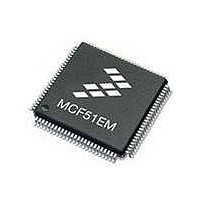MCF51EM256CLL Freescale Semiconductor, MCF51EM256CLL Datasheet - Page 492

MCF51EM256CLL
Manufacturer Part Number
MCF51EM256CLL
Description
IC MCU 32BIT 256KB FLASH 100LQFP
Manufacturer
Freescale Semiconductor
Series
MCF51EMr
Datasheets
1.MCF51EM128CLL.pdf
(2 pages)
2.MCF51EM128CLL.pdf
(54 pages)
3.MCF51EM128CLL.pdf
(636 pages)
Specifications of MCF51EM256CLL
Core Processor
Coldfire V1
Core Size
32-Bit
Speed
50MHz
Connectivity
I²C, SCI, SPI
Peripherals
LCD, LVD, PWM, WDT
Number Of I /o
63
Program Memory Size
256KB (256K x 8)
Program Memory Type
FLASH
Ram Size
16K x 8
Voltage - Supply (vcc/vdd)
1.8 V ~ 3.6 V
Data Converters
A/D 16x12b
Oscillator Type
External
Operating Temperature
-40°C ~ 85°C
Package / Case
100-LQFP
Processor Series
MCF51EM
Core
ColdFire V1
Data Bus Width
32 bit
Data Ram Size
16 KB
Interface Type
RS-232, LIN
Maximum Clock Frequency
50 MHz
Number Of Timers
3
Operating Supply Voltage
1.8 V to 3.6 V
Maximum Operating Temperature
+ 85 C
Mounting Style
SMD/SMT
3rd Party Development Tools
JLINK-CF-BDM26, EWCF
Development Tools By Supplier
DEMOEM
Minimum Operating Temperature
- 40 C
Lead Free Status / RoHS Status
Lead free / RoHS Compliant
Eeprom Size
-
Lead Free Status / Rohs Status
Lead free / RoHS Compliant
Available stocks
Company
Part Number
Manufacturer
Quantity
Price
Company:
Part Number:
MCF51EM256CLL
Manufacturer:
FREESCALE
Quantity:
110
Company:
Part Number:
MCF51EM256CLL
Manufacturer:
Freescale Semiconductor
Quantity:
10 000
- Current page: 492 of 636
- Download datasheet (11Mb)
Analog-to-Digital Converter (S08ADC16)
by the concatenation of ADCOFSH and ADCOFSL. The value in the offset correction registers
(ADCOFSH:ADCOFSL) is subtracted from the conversion and the result is transferred into the result
registers (ADCRHn:ADCRLn). If the result is above the maximum or below the minimum result value, it
is forced to the appropriate limit for the current mode of operation.For additional information please see
Section 21.5.8
The formatting of the ADC Offset Correction Register is different from the Data Result Registers
(ADCRHn:ADCRLn) to preserve the resolution of the calibration value regardless of the conversion mode
selected. Lower order bits are ignored in lower resolution modes. For example, in 8b single-ended mode,
the bits OFS[14:7] are subtracted from D[7:0]; bit OFS[15] indicates the sign (negative numbers are
effectively added to the result) and bits OFS[6:0] are ignored. The same bits are used in 9b differential
mode since bit OFS[15] indicates the sign bit, which maps to bit D[8]. For 16b differential mode, all bits
OFS[15:0] are directly subtracted from the conversion result data D[15:0]. Finally, in 16b single-ended
mode, there is no bit in the Offset Correction Register corresponding to the least significant result bit D[0],
so odd values (-1 or +1, etc.) cannot be subtracted from the result.ADCOFSH is automatically set
according to calibration requirements once the self calibration sequence is done (CAL is cleared). Write
ADCOFSH:ADCOFSL to override the calibration result if desired. If the Offset Correction Register is
written to a value that is different from the calibration value, the ADC error specifications may not be met.
It is recommended that the value generated by the calibration function be stored in memory before
overwriting with a specified value.
Use the offset calibration function to remove application offsets or DC bias values. The Offset Correction
Registers ADCOFSH and ADCOFSL may be written with a number in 2’s complement format and this
offset will be subtracted from the result (or hardware averaged value). To add an offset, store the negative
offset in 2’s complement format and the effect will be an addition. An offset correction that results in an
out-of-range value will be forced to the minimum or maximum value (the minimum value for single-ended
conversions is 0x0000; for a differential conversion 0x8000).
To preserve accuracy, the calibrated offset value initially stored in the ADCOFS registers must be added
to the user defined offset. For applications which may change the offset repeatedly during operation, it is
recommended to store the initial offset calibration value in flash so that it can be recovered and added to
any user offset adjustment value -nd the sum stored in the ADCOFS registers.
21.5.9
The ADC module includes a temperature sensor whose output is connected to one of the ADC analog
channel inputs.
where:
21-36
— V
Temperature Sensor
TEMP
There is an effective limit to the values of Offset that can be set. If the
magnitude of the offset is too great, the results of the conversions cap off at
the limits.
Equation 21-2
MCF51EM256 Series ColdFire Integrated Microcontroller Reference Manual, Rev. 8
is the voltage of the temperature sensor channel at the ambient temperature.
provides an approximate transfer function of the temperature sensor.
Temp = 25 - ((V
TEMP
NOTE
-V
TEMP25
) ÷ m)
Freescale Semiconductor
Eqn. 21-2
Related parts for MCF51EM256CLL
Image
Part Number
Description
Manufacturer
Datasheet
Request
R

Part Number:
Description:
BOARD DEMO HARDWARE ONLY
Manufacturer:
Freescale Semiconductor
Datasheet:

Part Number:
Description:
IC MCU 32BIT 128KB FLASH 100LQFP
Manufacturer:
Freescale Semiconductor
Datasheet:

Part Number:
Description:
IC MCU 32BIT 128KB FLASH 80LQFP
Manufacturer:
Freescale Semiconductor
Datasheet:

Part Number:
Description:
IC MCU 32BIT 256KB FLASH 80LQFP
Manufacturer:
Freescale Semiconductor
Datasheet:
Part Number:
Description:
Manufacturer:
Freescale Semiconductor, Inc
Datasheet:
Part Number:
Description:
Manufacturer:
Freescale Semiconductor, Inc
Datasheet:
Part Number:
Description:
Manufacturer:
Freescale Semiconductor, Inc
Datasheet:
Part Number:
Description:
Manufacturer:
Freescale Semiconductor, Inc
Datasheet:
Part Number:
Description:
Manufacturer:
Freescale Semiconductor, Inc
Datasheet:
Part Number:
Description:
Manufacturer:
Freescale Semiconductor, Inc
Datasheet:
Part Number:
Description:
Manufacturer:
Freescale Semiconductor, Inc
Datasheet:
Part Number:
Description:
Manufacturer:
Freescale Semiconductor, Inc
Datasheet:
Part Number:
Description:
Manufacturer:
Freescale Semiconductor, Inc
Datasheet:
Part Number:
Description:
Manufacturer:
Freescale Semiconductor, Inc
Datasheet:











